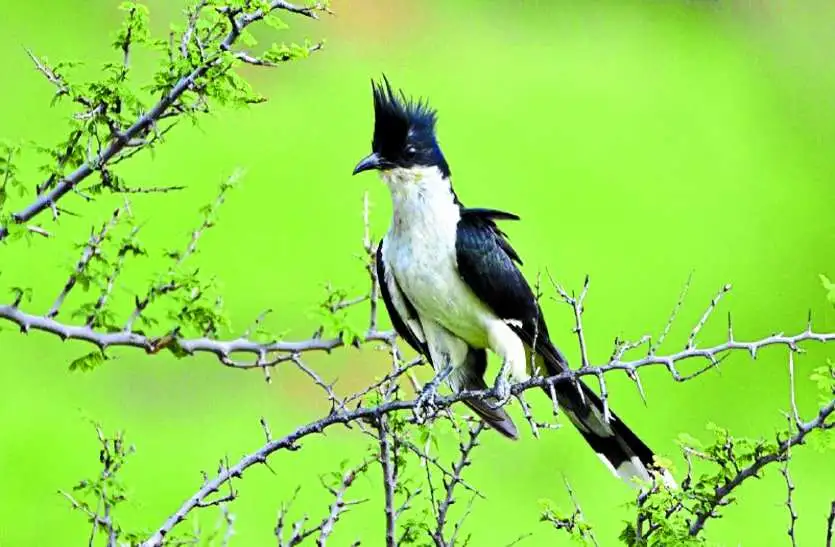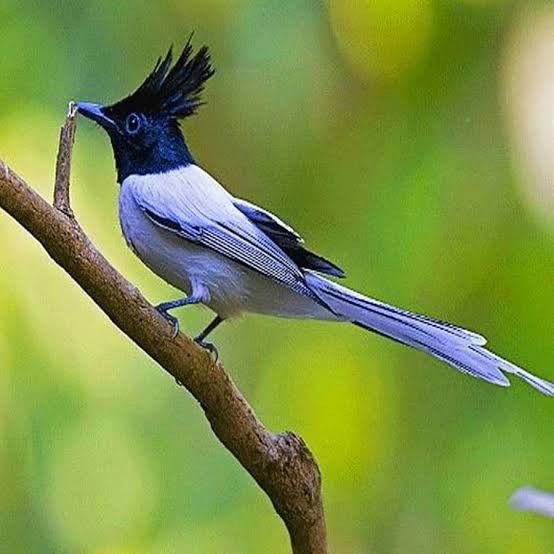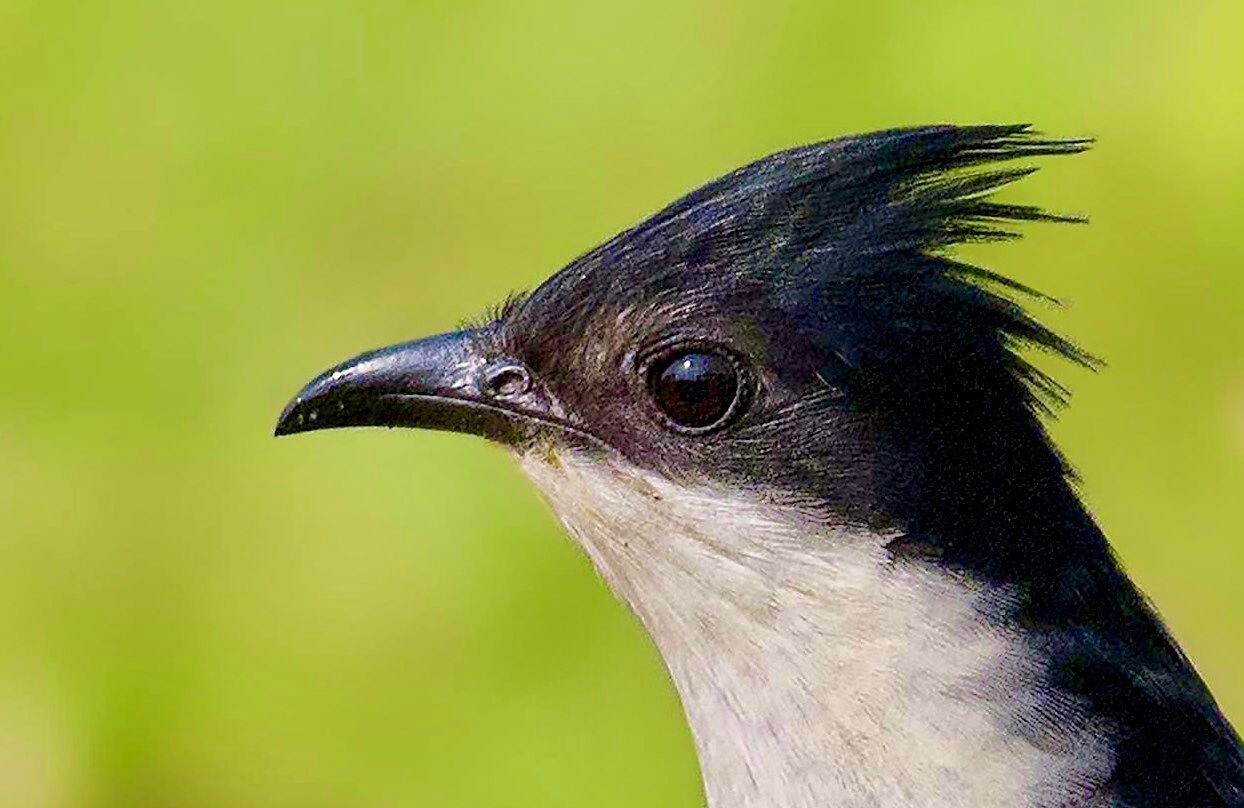Chatak Bird: A Comprehensive Exploration 2024
Posted on : March 25, 2024 By Savan

The Chatak bird, also known as the Pied Cuckoo or the Rain Bird, is a fascinating avian species that holds significant cultural and ecological importance in various parts of the world. From its unique behaviour to its mysterious habits, the Chatak bird has captured the curiosity of both scientists and enthusiasts alike. In this comprehensive exploration, we delve into everything known about the Chatak bird and uncover some lesser-known aspects that often escape the limelight.
Table of Contents

Introduction to the Chatak Bird:
The bird belongs to the Cuculidae family, known for its distinct call and behaviour. Scientifically classified as Clamator jacobinus, this bird species exhibits striking black and white plumage, with a long tail and slender body. Its melodious call is often associated with the arrival of the monsoon season, hence earning it the moniker “Rain Bird” in many cultures.
Chatak Bird Habitat and Distribution:
Birds are primarily found in South Asia, including countries such as India, Pakistan, Sri Lanka, Bangladesh, and Nepal. They inhabit a variety of habitats ranging from open woodlands, scrublands, agricultural fields, and urban areas. During the breeding season, Chatak birds are known to migrate to different regions within their range.
Behaviour and Ecology:
One of the most intriguing aspects of the bird is its behaviour, particularly its association with rainfall. According to folklore and cultural beliefs in many South Asian communities, the Chatak bird is believed to drink only rainwater, and its call is considered a harbinger of the monsoon rains.
Feeding Habits:
Chatak birds primarily feed on insects, including caterpillars, grasshoppers, and beetles. They are known to be adept at catching insects on the wing, displaying impressive agility and precision in their hunting techniques.
Breeding and Reproduction:
During the breeding season, which typically coincides with the onset of the monsoon,Birds construct nests in trees or shrubs. The female lays eggs, usually numbering between two to four, and both parents take turns incubating the eggs and caring for the young chicks after hatching.
Cultural Significance:
The Chatak bird holds significant cultural symbolism in various South Asian traditions. In Hindu mythology, it is associated with the god Indra, the deity of rain and thunderstorms. Additionally, the bird has been immortalized in poetry, literature, and art, symbolizing longing, anticipation, and the arrival of auspicious rains.
Conservation Status:
Despite its cultural significance, the bird faces various threats in its natural habitat. Habitat loss, pesticide use, and climate change are among the primary factors contributing to the decline in this bird population. Conservation efforts aimed at preserving their habitats and raising awareness about their ecological importance are crucial for their survival.

Uncovering Lesser-Known Facts:
1. Symbiotic Relationships:
While much is known about the Chatak bird’s association with rainfall, lesser-known are its symbiotic relationships with certain plant species. Some studies suggest that Chatak birds play a role in seed dispersal for certain plants, contributing to the regeneration of forests and ecosystems.
2. Migration Patterns:
While the general migration patterns of Chatak birds are well-documented, specific details about their migratory routes and destinations remain elusive. Advanced tracking technologies and satellite tagging could provide valuable insights into their movements and behaviour during migration.
3. Social Dynamics:
Despite being primarily solitary birds, Chatak birds occasionally exhibit social behaviours during the breeding season. Observations of communal roosting and cooperative feeding have been documented but are not well understood.
4. Vocalizations and Communication:
While the melodious call of the Chatak bird is well-known, the intricacies of its vocalizations and communication signals are still being studied. Researchers are exploring the nuances of Chatak bird calls to understand their role in mate attraction, territory defence, and social interactions.
5. Genetic Diversity:
Studies on the genetic diversity of Chatak bird populations across different regions are limited. Understanding the genetic structure of these populations could provide valuable insights into their evolutionary history and inform conservation strategies.
Conclusion:
In conclusion, the Pied Cuckoo bird is a captivating species that embodies the intersection of cultural significance and ecological importance. While much is known about its behaviour, habitat, and cultural symbolism, there are still many mysteries surrounding this enigmatic bird. By continuing to study and protect the Pied Cuckoo and its habitats, we can ensure the preservation of its cultural heritage and ecological role for future generations to appreciate and cherish.

Interactions of the Chatak Bird with Other Species and Humans
The Chatak bird, with its distinctive characteristics and behaviours, interacts with a diverse array of other species, including birds, animals, and humans. These interactions span ecological, social, and cultural dimensions, contributing to the intricate web of relationships in its environment.
1. Birds:
– Migratory Birds:
During migration, Chatak birds may encounter various migratory bird species sharing their habitats. While interactions can vary, competition for resources such as food and nesting sites might occur, influencing their behaviour and distribution.
– Predators and Prey:
Pied Cuckoo, like many avian species, play both predator and prey roles in their ecosystems. They hunt insects as prey but may also fall victim to predation by birds of prey such as hawks or owls.
2. Animals:
– Insects:
Pied Cuckoo primarily feed on insects, making them integral parts of insect populations’ dynamics. By controlling insect populations, they indirectly influence the abundance and diversity of insect species in their habitats.
– Mammals:
While Pied Cuckoo primarily interact with insects, they may occasionally encounter mammals such as rodents or small mammals in their foraging grounds. However, direct interactions between Chatak birds and mammals are limited.
3. Humans:
– Cultural Significance:
Humans have a deep cultural connection with the Pied Cuckoo, particularly in South Asian societies. Its association with the monsoon and the arrival of rain holds significant cultural symbolism, reflected in folklore, art, and rituals.
– Observation and Study:
Scientists and bird enthusiasts often observe and study Pied Cuckoos to understand their behaviour, ecology, and conservation needs. Citizen science initiatives and research projects involving local communities contribute to our knowledge of Chatak bird populations and their habitats.
– Human Impacts:
Human activities, such as habitat destruction, pollution, and climate change, can directly or indirectly impact Pied Cuckoo populations. Conservation efforts aimed at mitigating these threats and raising awareness about the bird’s ecological importance are essential for its survival.
– Urbanization:
As human settlements expand into natural habitats, Chatak birds may adapt to urban environments, leading to interactions with humans in parks, gardens, and green spaces. These interactions provide opportunities for birdwatching and environmental education but also raise concerns about habitat loss and urban wildlife management.
4. Mutualistic Relationships:
– Seed Dispersal:
Some studies suggest that Pied Cuckoos play a role in seed dispersal for certain plant species by consuming fruits and excreting seeds in different locations. This mutualistic relationship benefits both the birds and the plants, contributing to ecosystem health and regeneration.
5. Competition and Cooperation:
– Intraspecific Interactions:
Within Pied Cuckoo populations, individuals may compete for resources such as food, nesting sites, and mates. Social hierarchies and territorial behaviours influence interactions between individuals, shaping population dynamics and distribution.
– Interactions with Other Species:
Pied Cuckoo may compete with other bird species for resources, leading to interspecific competition. However, they may also form cooperative relationships with other bird species, particularly during migration or in mixed-species foraging flocks.
In essence, the Pied Cuckoo’s interactions with other species and humans are multifaceted, encompassing ecological, social, and cultural dimensions. Understanding these interactions is crucial for conservation efforts and for fostering harmonious relationships between humans and the natural world.
The lifespan of Chatak birds
The lifespan of Chatak birds, also known as Pied Cuckoos or Rain Birds, can vary depending on factors such as habitat, predation, and environmental conditions. While specific data on the lifespan of Pied Cuckoo in the wild is limited, observations and studies provide some insight into their longevity.
In general, smaller bird species tend to have shorter lifespans compared to larger birds. Pied Cuckoo, being medium-sized birds, typically have lifespans ranging from 4 to 8 years in the wild. However, under optimal conditions with abundant food resources and minimal predation, some individuals may live slightly longer.
Factors influencing the lifespan of Chatak birds include:
1. Predation:
Predation is a significant threat to Chatak birds, especially during nesting and fledgling stages when they are more vulnerable. Predators such as birds of prey, snakes, and mammals may prey on Chatak eggs, chicks, or even adult birds, reducing their overall lifespan.
2. Habitat and Environmental Conditions:
Habitat quality and environmental factors play crucial roles in determining the health and longevity of Chatak birds. Access to suitable nesting sites, availability of food resources, and exposure to environmental stressors such as pollution and climate change can impact their survival rates and lifespan.
3. Disease and Parasites:
Like all wildlife, Chatak birds are susceptible to diseases and parasitic infections, which can affect their health and lifespan. Diseases transmitted by mosquitoes, ticks, and other vectors, as well as internal parasites, may pose threats to Chatak bird populations.
4. Migration:
Chatak birds are migratory species, undertaking long-distance journeys between breeding and wintering grounds. The rigors of migration, including navigation challenges, exposure to adverse weather conditions, and the risk of exhaustion, can influence their survival and overall lifespan.
5. Human Interactions:
Human activities such as habitat destruction, pollution, and urbanization can directly or indirectly impact Chatak birds and their habitats, affecting their survival rates and lifespan. Conservation efforts aimed at mitigating human impacts and preserving critical habitats are essential for the long-term viability of Chatak bird populations.
While Chatak birds face various challenges in the wild, their ability to adapt to changing environments and their role in ecosystems underscores the importance of conservation measures to ensure their continued survival. By addressing threats to their habitats and implementing sustainable management practices, we can help safeguard Chatak birds and promote biodiversity conservation.
Certainly! Here are some interesting facts about Chatak birds:
1. Monsoon Harbinger:
Pied Cuckoo are often considered harbingers of the monsoon season in South Asian cultures. Their arrival is eagerly awaited as it signals the imminent onset of the rainy season, essential for agriculture and livelihoods in the region.
2. Unique Feeding Behavior:
Chatak birds have a fascinating feeding behaviour where they primarily consume insects, especially during the breeding season. What’s intriguing is that they are known to avoid drinking water directly, relying instead on the moisture content of the insects they consume.
3. Mimicry Skills:
Like other cuckoo species, Chatak birds possess impressive mimicry skills. They can imitate the calls of other bird species, which may serve various purposes including territorial defence or attracting mates.
4. Breeding Parasitism:
Chatak birds are not brood parasites like some other cuckoo species; however, they have been observed laying their eggs in the nests of other birds, such as babblers and prinias. This behaviour, known as “nest parasitism,” allows them to offload some of the parental responsibilities onto other bird species.
5. Cultural Symbolism:
The Chatak bird holds significant cultural symbolism in South Asian mythology and literature. It is often depicted as a symbol of longing, anticipation, and the cyclical nature of life, particularly in poetry and art.
6. Long-Distance Migration:
Chatak birds undertake remarkable long-distance migrations, travelling thousands of kilometres between their breeding grounds in South Asia and their wintering grounds in Africa. Their migratory journeys are fraught with challenges, yet they demonstrate incredible navigational abilities.
7. Adaptation to Urban Environments:
While traditionally associated with rural landscapes, Chatak birds have shown adaptability to urban environments. They can be found nesting and foraging in parks, gardens, and green spaces within cities, highlighting their ability to coexist with humans.
8. Cultural Festivals:
In some parts of South Asia, festivals and rituals are dedicated to the Chatak bird, celebrating its association with rain and fertility. These festivals often involve rituals aimed at invoking rain and ensuring agricultural prosperity.
9. Conservation Concerns:
Despite their cultural significance and ecological importance, Chatak birds face various conservation challenges, including habitat loss, pesticide use, and climate change. Conservation efforts aimed at protecting their habitats and raising awareness about their conservation needs are essential for their survival.
10. Research Opportunities:
Chatak birds present exciting research opportunities for scientists studying avian behaviour, ecology, and migration. Ongoing research projects seek to unravel the mysteries surrounding their migration patterns, vocalizations, and population dynamics.
These fascinating facts about Chatak birds underscore their unique characteristics and their significance in both natural ecosystems and human cultures. Studying and conserving these birds not only contributes to our understanding of avian biology but also highlights the interconnectedness of humans and wildlife in shared landscapes.

The evolution of Chatak birds
The evolution of Chatak birds, also known as Pied Cuckoos or Rain Birds, is a fascinating subject that sheds light on their adaptation to diverse environments and their place in avian evolutionary history. While specific details of their evolutionary lineage may not be fully documented, we can glean insights into their evolution through comparative studies with related species and analysis of their morphology, behaviour, and genetics.
1. Taxonomic Classification:
Chatak birds belong to the family Cuculidae, which includes various species of cuckoos, coucals, and malkohas. Within this family, Chatak birds are classified under the genus *Clamator,* along with other cuckoo species.
2. Ancestral Traits:
Like other members of the cuckoo family, Chatak birds exhibit certain ancestral traits that have been retained over evolutionary time. These traits include the characteristic cuckoo shape, with a slender body, long tail, and pointed wings, which are adaptations for agile flight.
3. Adaptations for Brood Parasitism:
While Chatak birds themselves are not obligate brood parasites like some cuckoo species, they exhibit behaviours associated with brood parasitism, such as laying their eggs in the nests of other bird species. This suggests an evolutionary link to ancestral cuckoos that engaged in brood parasitism as a reproductive strategy.
4. Feeding Ecology:
The feeding ecology of Chatak birds, primarily insectivorous, reflects adaptations to their environment and dietary preferences. Their ability to catch insects on the wing and their reliance on rainfall for hydration may have evolved in response to the seasonal availability of prey and water resources.
5. Migration Patterns:
The long-distance migration of Chatak birds between breeding and wintering grounds suggests evolutionary adaptations for navigating vast distances and coping with environmental challenges along migratory routes. Genetic studies may provide insights into the evolutionary history of migration in Chatak birds and related species.
6. Habitat Preferences:
Chatak birds inhabit a range of habitats, including open woodlands, scrublands, agricultural areas, and urban environments. Their ability to thrive in diverse habitats may reflect adaptations to changing landscapes over evolutionary time, including habitat fragmentation and anthropogenic disturbance.
7. Social and Reproductive Behavior:
Chatak birds exhibit social and reproductive behaviours that are shaped by evolutionary pressures, including mate selection, territorial defence, and parental care. Comparative studies with other cuckoo species may elucidate the evolutionary origins of these behaviours and their adaptive significance.
8. Genetic Diversity:
Genetic studies of Chatak bird populations can provide insights into their evolutionary relationships with other cuckoo species and their genetic diversity across different geographic regions. Understanding patterns of genetic variation may help infer historical population dynamics and evolutionary processes shaping Chatak bird populations.
In summary, the evolution of Chatak birds is a complex interplay of genetic, ecological, and behavioural factors that have shaped their adaptation to diverse environments and ecological niches. Further research into their evolutionary history and genetic makeup will enhance our understanding of these captivating avian species and their place in the evolutionary tree of life.
Share this articlePosted on : March 25, 2024 By Savan
Join Our Club

"Stay Informed, Stay Ahead – Join Our Club Today!"



















